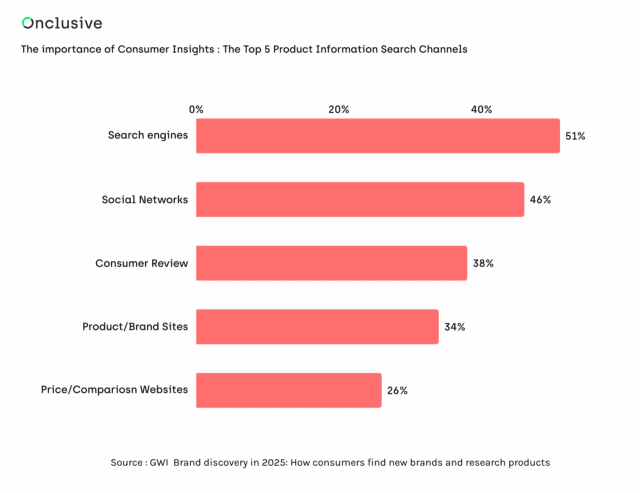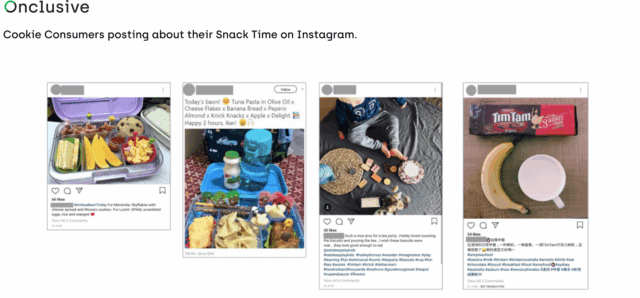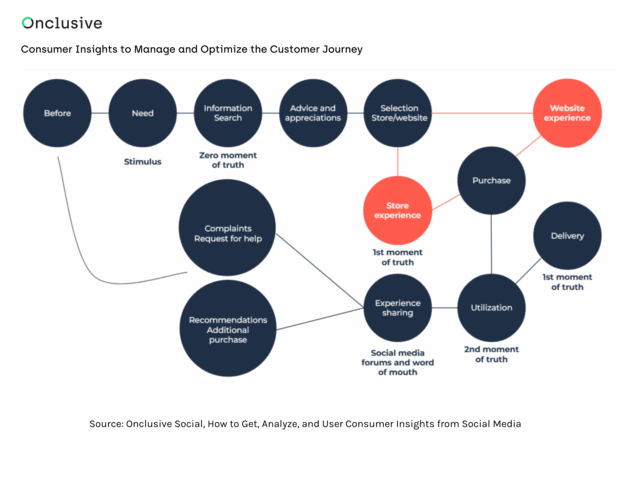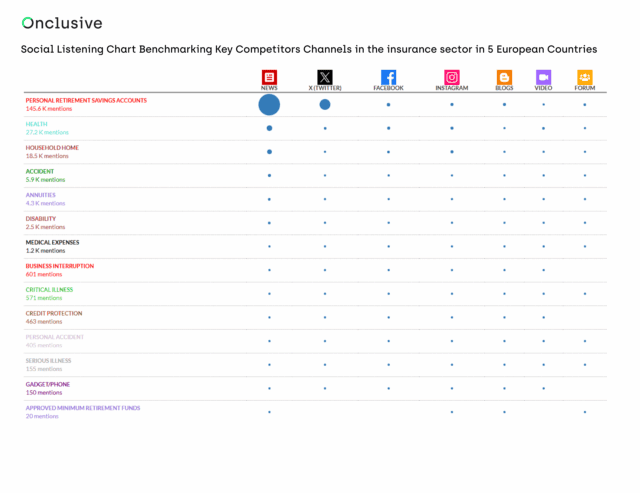Social media has transformed the way people discover, evaluate, and talk about brands. Every post, comment, review, or hashtag leaves a digital trail that can reveal what consumers really think. For businesses, this is not background noise — it is a constant stream of intelligence that can inform smarter decisions. Yet, many organisations still underuse this wealth of information. They may track likes and mentions, but they fail to turn conversations into actionable insights. With the right approach, social media can act as a live research lab that is faster, broader, and more authentic than most traditional methods. This guide explains what social media insights are, why they matter, and how to use them to drive value across your organisation.
Table of contents
Key Takeaways
Definition: What is a social media insight?
Why social media insights matter
Where consumers look for information
Which platforms to analyse
Five benefits of social media insights
10 practical ways to use social media insights
Bringing it all together
FAQs: Consumer Insights in Social Media
Key Takeaways
Social media insights provide authentic, unfiltered consumer intelligence from natural online conversations, revealing what people really think and do versus what they might say in surveys.
With nearly all consumers checking online reviews before purchasing and social media driving almost a third of product research globally, monitoring these conversations is no longer optional—it’s essential for understanding market dynamics and customer expectations.
The most successful brands integrate social insights across all departments, using them to optimize everything from product features and brand positioning to customer journey friction points and campaign messaging, turning everyday conversations into actionable business intelligence.
Definition: What is a social media insight?
A social media insight is a piece of consumer knowledge uncovered by analysing online conversations. It might be the reason a product resonates with one community but falls flat with another, or the spark of a new trend before it hits the mainstream.
Unlike survey responses, which are prompted and structured, social media conversations happen naturally. This spontaneity often reveals what people are really thinking and doing, making the insights more authentic and more powerful.
I. Why social media insights matter
Omnipresent
People are constantly sharing opinions — on review sites, in forums, and across every social network. If your brand is not paying attention, you risk missing conversations that shape perception and influence purchase decisions.
Dynamic
Conversations change daily. A WiserReview study shows that almost all consumers check online reviews before buying. That means one positive or negative comment can influence thousands of purchase journeys. Brands that monitor these signals can respond in time, instead of reacting too late.
Complementary
Social data is not a replacement for traditional market research. Instead, it adds texture. Surveys and focus groups answer specific questions. Social conversations show unfiltered reactions. Together, they provide a rounded view of what customers say and what they do.
II. Where consumers look for information
The consumer research journey is no longer linear. People may start with a search engine, scroll through TikTok, check TripAdvisor, and even ask an AI tool before making a decision.
- McKinsey reports that social media now drives almost a third of product research globally, with even higher figures in fast-growing markets.
- Storyblok found that 17% of consumers already rely on AI as their primary source of product information.
- Bain & Company revealed that four in ten users of large language models turn to them for shopping recommendations.
Generational differences add another layer. Gen Z and millennials turn to social platforms first, while Gen X and baby boomers remain more reliant on search engines. Knowing these behaviours allows brands to meet people where they are.

The importance of Consumer Insights : The Top 5 Product Information Search Channels
III. Which platforms to analyse
It is easy to assume that only Facebook, Instagram, or TikTok matter. In reality, consumers use dozens of platforms to share opinions and experiences. Depending on your audience, insights might be hiding in places such as Discord, Reddit, or Pinterest.
The key is to match your monitoring to your audience. A B2B company may find LinkedIn invaluable, while a hospitality brand may need to prioritise TripAdvisor and Google Reviews. Casting a wide net ensures you do not miss critical conversations.
IV. Five benefits of social media insights
1. Understanding Real-Time Behaviors
One of the greatest advantages of social media insights is their immediacy. Unlike traditional market research that can take weeks or months to organize and analyze, social conversations unfold live. You can observe how consumers react to a product launch, advertising campaign, or even news affecting your sector the moment it happens.
This real-time monitoring capability allows brands to quickly detect emerging trends, identify issues before they become crises, and seize opportunities while they’re still fresh. For example, if a competitor’s product encounters a quality issue, you can adjust your positioning immediately. If a cultural event creates a viral moment, you can participate in the conversation authentically.
2. Saving on Research Costs
Traditional market research methods—focus groups, large-scale surveys, consumer panels—represent significant financial investments. Social media insights offer a much more economical complementary alternative.
The conversations you analyze already exist. Consumers voluntarily share their opinions, experiences, and frustrations without needing to be recruited or compensated. This goldmine of information can serve as an initial discovery phase, helping you identify key questions to explore more deeply with more expensive research methods.
Moreover, social listening tools can continuously monitor thousands of conversations simultaneously, a scale level impossible to achieve with traditional manual methods. This maximizes your return on investment in consumer research.
3. Gathering Unfiltered Feedback
Surveys and focus groups have an inherent bias: participants know they’re being observed. This phenomenon, known as the Hawthorne effect, can influence their responses. People tend to give the answers they think are expected or socially acceptable rather than expressing their true opinions.
On social media, conversations are organic and spontaneous. Consumers share their real frustrations, authentic joys, and honest opinions without worrying about pleasing a researcher. This authenticity often reveals surprising insights that traditional methods would have missed.
A consumer might not say in a survey that they find your packaging difficult to open, but they’ll certainly mention it in a frustrated tweet at 11pm when desperately trying to access your product. These moments of truth are invaluable for understanding the real customer experience.
4. Improving Customer Experience
The modern customer journey is complex and multi-touchpoint. Social media insights allow you to track consumer sentiment and behaviors at every stage: from initial awareness to consideration, purchase, use, and even loyalty or disengagement.
By analyzing social conversations, you can precisely identify where friction points lie in your customer journey. Perhaps consumers love your product but hate your after-sales service. Or maybe they’re enthusiastic at purchase but encounter difficulties during first use.
This granular visibility enables targeted improvements that have a real impact on customer satisfaction. Additionally, by monitoring sentiment continuously, you can measure the effectiveness of your interventions and adjust your approach accordingly.
5. Optimizing Campaigns and Products
Social media insights provide concrete evidence to guide your strategic decisions. Instead of relying solely on intuition or assumptions, you have real data from authentic conversations to validate or invalidate your ideas.
For marketing campaigns, you can test messages, identify which visuals resonate most, discover which influencers actually have impact with your audience, and understand which channels generate the most engagement. This information allows you to allocate your budgets more effectively and create content that truly connects with your target.
For product development, social conversations reveal which features consumers demand, what problems they encounter with existing products (yours and your competitors’), and what innovations could fill a market gap. This intelligence can directly feed your product roadmap and reduce the risk of failure at launches.
V. 10 practical ways to use social media insights
- Spot consumption habits
Snack brands have discovered recipe-focused content dominates conversation, shaping campaigns around it. - Understand communities
An alcohol brand learned vegan consumers were driving the majority of conversations about its new whiskey, guiding its targeting strategy. - Optimise product features
A geolocation brand reintroduced physical buttons after social data revealed frustration with touch-only devices. - Refresh brand communication
A vodka brand repositioned itself as “Made in America” after negative sentiment linked it with Russia. - Map moments of consumption
Food and drink brands now adapt packaging and messaging based on when consumers post about breakfast, snacks, or late-night treats.

Cookie Consumers posting about their Snack Time on Instagram.
6. Evaluate the customer journey
Social listening tools capture insights across every stage, helping brands identify and resolve friction points.

Consumer Insights to Manage and Optimize the Customer Journey via Onclusive
7. Benchmark competitors
An insurance provider redesigned its contracts after spotting widespread complaints about competitor policies.

Social Listening Chart Benchmarking Key Competitors Channels in the insurance sector in 5 European Countries (via Onclusive Social Listening Tool)
8. Identify new influencers
Gaming brands shifted strategy to Twitch after noticing that key communities had migrated from video platforms.
9.Track emerging trends
A consumer tech company analysed 500 influencers to connect with fashion-tech crossovers, inspiring new campaign ideas.
10. Optimise campaign launches
A gaming brand reshaped its messaging after tracking sentiment and influencers around a new product, helping overcome negative perceptions.
VI. Bringing it all together
The value of social media insights lies not only in the data itself, but in what you do with it. The most successful brands are those that integrate insights across departments — from marketing and PR to product development and customer service.
With billions of consumers generating content daily, there is no shortage of information. The challenge is cutting through the noise to find insights that matter. That is where social listening tools such as Onclusive Social can help.
By turning conversations into intelligence, you can build stronger campaigns, design better products, and create experiences that meet real customer expectations.
 To explore how Onclusive can help you capture and apply social media insights, book a free demo with our experts today.
To explore how Onclusive can help you capture and apply social media insights, book a free demo with our experts today.
FAQs: Consumer Insights in Social Media
How are social media insights different from traditional market research?
Social media insights offer spontaneous, unfiltered feedback that happens in real-time, while traditional research (surveys, focus groups) provides structured responses to specific questions. Social insights are complementary—they add texture and authenticity to traditional research rather than replacing it. Together, they provide a complete picture of what customers say versus what they actually do.
Are social media insights reliable for business decisions?
Yes, when properly analyzed. Social media insights capture authentic consumer behavior and opinions as they naturally occur. Studies show that nearly all consumers check online reviews before purchasing, and social media drives almost a third of product research globally. This makes social insights a critical component of understanding your market.
Which social media platforms should we monitor for insights?
Don’t limit yourself to major platforms like Facebook, Instagram, or TikTok. Consumers share opinions across dozens of platforms including:
- Review sites (TripAdvisor, Google Reviews)
- Forums (Reddit, Discord)
- Professional networks (LinkedIn for B2B)
- Visual platforms (Pinterest, YouTube)
- Gaming platforms (Twitch)
Match your monitoring to where your specific audience congregates.
How do different generations use social media for product research?
Generational preferences vary significantly:
- Gen Z and Millennials: Turn to social platforms first for product information
- Gen X and Baby Boomers: Still rely more heavily on search engines
- Emerging trend: 17% of all consumers now use AI as their primary source of product information
- Cross-generational: 40% of large language model users turn to them for shopping recommendations
Do we need specialized tools for social media insights?
While manual monitoring is possible for small-scale efforts, professional social listening tools like Onclusive Social are essential for comprehensive insights. These tools help:
- Cut through billions of daily posts to find relevant conversations
- Track sentiment across multiple platforms simultaneously
- Identify trends and patterns humans might miss
- Generate actionable reports for different departments
How do we measure ROI from social media insights?
Track metrics such as:
- Reduced customer complaints after addressing identified pain points
- Improved campaign performance based on insight-driven adjustments
- Product innovations inspired by customer feedback
- Crisis mitigation from early issue detection
- Cost savings from more targeted marketing efforts
- Customer retention improvements from better experience management

